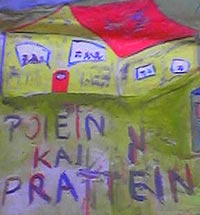Thomas Monses
When entering his studio in Neu Köln, Berlin, it was immediately evident here resides a young artist engaged in what he is doing. The small apartment in the backyard exemplifies also why it is possible for Berlin to attract so many artists. There is still available space which is relatively inexpensive. He shares his apartment with one other artist. Besides the table there can be seen a stable of empty Pizza boxes - evidence of quick meals while continuing to work. Around the four walls of the main studio with a Kachelofen - tile oven - in the corner, one can be seen his most recent works. They are about to be exhibited in Amsterdam where he had lived for ten years.
The interesting aspect about Thomas Monses is that he did not stay only in Amsterdam, but spend as well some time in Japan, and like Van Gogh before him, this experience has transformed his approach to art.
Entering a discussion with his art, is to inquire what the form says for that is a clear entry of photography into drawing and vice versa.

To describe the work of Thomas Monses in 2011, here it means to pick up the conversation where he can be met at this moment. He has just moved from Amsterdam to Berlin to reside, as said already, in Neu Koeln. He lives in that special district as of November there for only four months, but he has already experienced other districts in Berlin like Kreuzberg. Thus the flow of ideas taking artists to various places continues to evoke a novelty in the approach to art.
When dealing with photography everything is like a 'moment aufnahme' - image of the moment. It is a split second of reality. But once the photo is taken, there is a need to extend the moment into something like a painting. For it should be able to let the passer-by or the fleeting eye to pause and to take a second look. By including in the photograph his own special technique of drawing as learned in Japan, and which entails special ink, there begins a path which is not a digital one. That brings then other images to mind. Aesthetically speaking, his photography turned into drawing takes on light. As such it allows the viewer to feel and to see how the transcription of the image onto paper starts to take shape. There is one key element being used diligently, namely the effervescent light. It is the key to the form in the making.
At the same time, it allows the viewer to be startled, and to become more pensive, but only after taking a second look. For example, in his photo of Japanese children playing in a yard, the light seems to be indifferent to radiation emerging out of the split atom. But in that split second this can happen. Thomas Monses says it was not his intention to underline this potential, but that came out in the process and was substantiated by what took place in reality thereafter.

He calls this scene of children in a school yard 'atom of peace'. A lot can be read into the shadow and into the motion of the child running in the foreground. As he narrates himself without intending to do so, this scene took on the connotation to Fukushima and what has happened in Japan since March 11th 2011. At that time the Tsunami wave hit the coastline where nuclear reactors are irresponsibly located i.e. too close to the sea. The nuclear reactor was damaged even if protected by a ten meter high wall. Since then Japan has to live with similar things happening as was the case in Chernobyl.
There has been developed as of late, and ever since Boudewijn Payens and Insa Winkler showed their action in Chernobyl ten years after the accident there, a discussion on how artists can make visible the danger of something not to be perceived by the senses? Radiation cannot be touched, tasted, seen, heard or felt, but through the knowledge mankind has acquired in the meantime the knowledge 'it' is there. It is radiation which contaminates everything: earth, clothes, food and eventually the human body.
The same applies to the pictures of Thomas Monses: the visibility is a contradiction to what remains invisible, but is there. He depicts the latter not as something standing in the shadow, but which is much more directly invisible and thus existing equally in the middle of the school yard, there where the children are playing. Since it is not possible to escape for radiation is everywhere, the very innocence of a girl playing with a hoop in the schoolyard belies the political lie that this reality is safe and sound. As such the picture underlines the human anguish when forced to live and to play in an atmosphere subject to such a dangerous exposure. And it is art to make this point more indirect than direct.
Despite this difficult task to show what is invisible, what can be shown directly as evidence is the destruction itself. Heaps of metals brought together in a senseless way provides proof what the path of destruction entails in the aftermath. Life has returned apparently to the quality of still life, but it has been severely disturbed. As someone would say, an order may be restored but it shall no longer be the one where human beings met and lived before the disaster struck.

Further information about the works of Thomes Monses can be obtained at his own website:
www.themoonsmass.wordpress.com
Hatto Fischer
Athens 3.12.2011
Einladung zur Ausstellung 'Zeitzonen' / Invitation exhibition 'Zeitzonen'
« Boudewijn Payens | Pantelis Sabaliotis »
